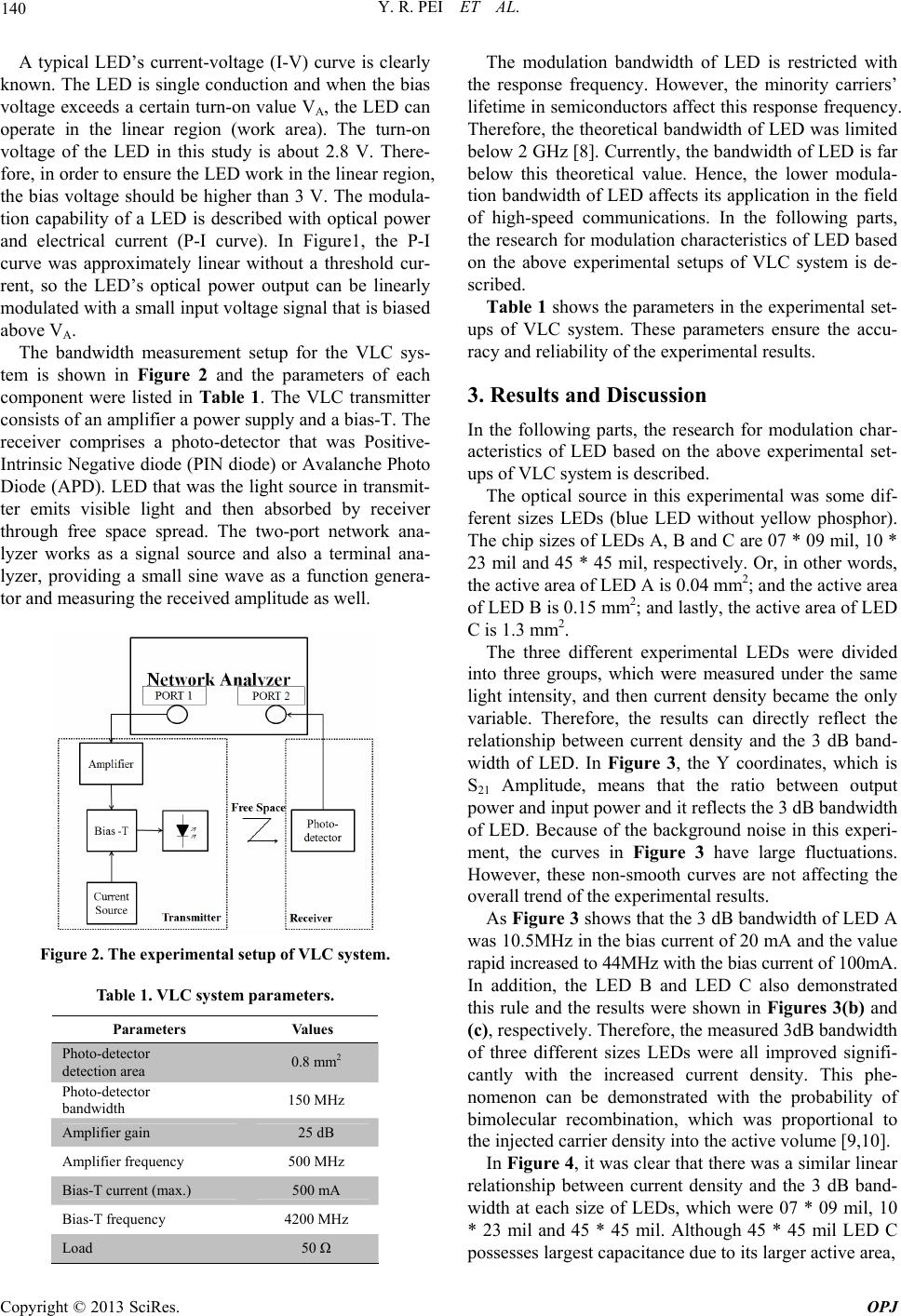
Y. R. PEI ET AL.
140
A typical LED’s current-voltage (I-V) curve is clearly
known. The LED is single conduction and when the bias
voltage exceeds a certain turn-on value VA, the LED can
operate in the linear region (work area). The turn-on
voltage of the LED in this study is about 2.8 V. There-
fore, in order to ensure the LED work in the linear region,
the bias voltage should be higher than 3 V. The modula-
tion capability of a LED is described with optical power
and electrical current (P-I curve). In Figure1, the P-I
curve was approximately linear without a threshold cur-
rent, so the LED’s optical power output can be linearly
modulated with a small input voltage signal that is biased
above VA.
The bandwidth measurement setup for the VLC sys-
tem is shown in Figure 2 and the parameters of each
component were listed in Table 1. The VLC transmitter
consists of an amplifier a power supply and a bias-T. The
receiver comprises a photo-detector that was Positive-
Intrinsic Negative diode (PIN diode) or Avalanche Photo
Diode (APD). LED that was the light source in transmit-
ter emits visible light and then absorbed by receiver
through free space spread. The two-port network ana-
lyzer works as a signal source and also a terminal ana-
lyzer, providing a small sine wave as a function genera-
tor and measuring the received amplitude as well.
Figure 2. The experimental setup of VLC system.
Table 1. VLC system parameters.
Parameters Values
Photo-detector
detection area 0.8 mm2
Photo-detector
bandwidth 150 MHz
Amplifier gain 25 dB
Amplifier frequency 500 MHz
Bias-T current (max.) 500 mA
Bias-T frequency 4200 MHz
Load 50 Ω
The modulation bandwidth of LED is restricted with
the response frequency. However, the minority carriers’
lifetime in semiconductors affect this response frequency.
Therefore, the theoretical bandwidth of LED was limited
below 2 GHz [8]. Currently, the bandwidth of LED is far
below this theoretical value. Hence, the lower modula-
tion bandwidth of LED affects its application in the field
of high-speed communications. In the following parts,
the research for modulation characteristics of LED based
on the above experimental setups of VLC system is de-
scribed.
Table 1 shows the parameters in the experimental set-
ups of VLC system. These parameters ensure the accu-
racy and reliability of the experimental results.
3. Results and Discussion
In the following parts, the research for modulation char-
acteristics of LED based on the above experimental set-
ups of VLC system is described.
The optical source in this experimental was some dif-
ferent sizes LEDs (blue LED without yellow phosphor).
The chip sizes of LEDs A, B and C are 07 * 09 mil, 10 *
23 mil and 45 * 45 mil, respectively. Or, in other words,
the active area of LED A is 0.04 mm2; and the active area
of LED B is 0.15 mm2; and lastly, the active area of LED
C is 1.3 mm2.
The three different experimental LEDs were divided
into three groups, which were measured under the same
light intensity, and then current density became the only
variable. Therefore, the results can directly reflect the
relationship between current density and the 3 dB band-
width of LED. In Figure 3, the Y coordinates, which is
S21 Amplitude, means that the ratio between output
power and input power and it reflects the 3 dB bandwidth
of LED. Because of the background noise in this experi-
ment, the curves in Figure 3 have large fluctuations.
However, these non-smooth curves are not affecting the
overall trend of the experimental results.
As Figure 3 shows that the 3 dB bandwidth of LED A
was 10.5MHz in the bias current of 20 mA and the value
rapid increased to 44MHz with the bias current of 100mA.
In addition, the LED B and LED C also demonstrated
this rule and the results were shown in Figures 3(b) and
(c), respectively. Therefore, the measured 3dB bandwidth
of three different sizes LEDs were all improved signifi-
cantly with the increased current density. This phe-
nomenon can be demonstrated with the probability of
bimolecular recombination, which was proportional to
the injected carrier density into the active volume [9,10].
In Figure 4, it was clear that there was a similar linear
relationship between current density and the 3 dB band-
width at each size of LEDs, which were 07 * 09 mil, 10
* 23 mil and 45 * 45 mil. Although 45 * 45 mil LED C
possesses largest capacitance due to its larger active area,
Copyright © 2013 SciRes. OPJ